The Holy Infant of Prague
The Church of Our Lady Victorious in the Czech Capital of Prague is also home to the shrine of the Infant of Prague. Growing up, it always fascinated me how elaborate this image was compared with other portrayals of Jesus. On visiting the shrine recently, I was equally fascinated to see that the statue was very much in keeping with its ornate surroundings.
The church itself was built in the early 17th century in part-Renaissance and part-Baroque styles. The church’s interior can be a bit overwhelming with its marble, gold, and decorative features. The Discalced Carmelites, who managed the church, were determined to us
e only the best artists and craftsmen of the 17th and 18th centuries, so, despite the extravagance of the building, it’s impossible not to be impressed, particularly with the altar of the Infant Jesus of Prague.
The little statue sits within the marble arch, which in turn is surrounded by pillars, all marble, decorated in gold trimmings, and statues. At the top, a gold ‘sun’ has the Dove in its centre, below which is the figure of God, and at the very bottom of the altar is Jesus on the Cross. In the centre on the left is Mary, with her Son, the Infant, and St Joseph on the right. Thus the Trinity is represented in both forms, spiritual – vertical; and earthly -- horizontal.
At 47cm high, the Infant is small but impressive. It is made of wood, fabric and wax, and its robes are coloured according to the liturgical seasons – green, purple, red or gold; and royal blue for the feasts of the Immaculate Conception and the Assumption.
Dressing the statue is an act of veneration and a long-held tradition. The golden, jewelled crown, which usually adorns the Infant, was given by Pope Benedict XVI when he visited the church in 2009. The little King has his right hand raised in blessing, while his left hand is holding a globus cruciger – a cross-bearing orb -- symbolising his holding the world in his hands.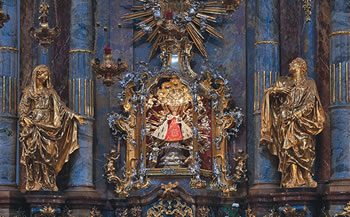
It is believed that the statue comes from Spain, made some time in the 1500s. Various stories surround its origins. One says it belonged to St Teresa of Avila, who encouraged devotion to the Child Jesus through her own devotion to Him. It is said she gave it as a wedding gift to a friend’s daughter who was marrying in Prague. Another story has it that a monk made the statue after receiving a vision of the Infant. It is known that it was taken to Prague in 1556 by the Spanish Duchess Marie Manriquez de Lcara, who married Vratislav of Pernstejn.
Her daughter, Polyxena, who had it given to her on her wedding day, later donated it to the monastery of Discalced Carmelites in 1628.
The statue was greatly revered in the monastery’s oratory, where twice daily devotions and novitiate vows took place before the Infant Jesus. These practices ceased when the Thirty Years War intervened in 1631 and King Adolphus of Sweden’s army took Prague. The monastery was ransacked and the little statue, its arms broken off, was discarded, along with other damaged items, at the back of the altar. In 1637 when the monks returned to Prague, Father Cyril of the Mother of God, who had a devotion to the Infant, came also. He discovered the statue and placed it in the oratory. While praying, he heard Jesus say, “Have mercy on me and I will have mercy on you. Give me my arms and I will give you my peace. I will bless you as much as you will venerate me”.
The arms were duly replaced, and true to His word, Jesus began to bless, not just the monks, but the whole of Prague. As devotion to the Infant Jesus increased, reports of miraculous healings, petitions answered, and showers of blessings were continually heard.
For the next eighty-six years, veneration of the Infant Jesus continued to grow, until, in 1741, it was decided to move the statue further inside the church to accommodate the crowds pouring in. Its present position to the centre right was its final resting place, and in 1776, the surrounding alcove was built.
Upheaval was not far away, though. In 1784, the monasteries were dissolved under Josef II, the Carmelites departed, and the church fell into neglect, along with the precious statue. More than a hundred years later, In 1879, a pilgrimage to Prague’s holy places carrying the Infant raised the money needed for its restoration. Devotion was renewed, and far beyond the streets of Prague; the word was spreading around the world. By 1935, the Americas, parts of Asia and the Philippines were all becoming aware of the Infant of Prague.
The Second World War in 1939, followed by Communist rule, affected open devotion to the Infant. Pilgrimages were still made to Prague, but not in the numbers they were before the war. It was with the Carmelites’ return to Our Lady Victorious in 1993 that veneration truly resumed and gathered momentum. Today, thousands of people visit the shrine every year and the image of the Divine Child on prayer cards and statues can be found throughout the world.
Saints such as Anthony of Padua and Francis of Assisi had devotion to the Infant of Prague, along with Thérèse of Lisieux, who is also known as St Thérèse of the Child Jesus. One of the prayers she composed spoke of her child-like confidence in God: “O eternal Father, your only Son, the dear Child Jesus, is mine, since you have given him to me. I offer you the infinite merits of his divine childhood, and I beg you in his name to open the gates of heaven to a countless host of little ones who will forever follow this divine Lamb”.
Not surprisingly, this image of the Child Jesus is the Patron of children and schools, along with good health, good finances and vocations. On his 2009 visit, Pope Benedict XVI said special prayers for children from broken families and victims of violence.
When I was growing up, every Catholic family had some representation of the Infant in their homes. Perhaps it’s time we revived this tradition. Another translation of the promise made to Father Cyril is “The more you honour me, the more I will bless you”. How can we not want that!
Prayer To Blessed Virgin Mary
O most beautiful flower of Mount Carmel, fruit of the vine, splendour of heaven. Blessed Mother of the Son of God. Immaculate Virgin, assist me in this my necessity. O Star of the Sea, help me and show me herein you are my mother. O Holy Mary, Mother of God, Queen of heaven and earth, I humbly beseech you from the bottom of my heart to succour me in my necessity . There are none that withstand your power. O show me here you are my mother. O Mary, conceived without sin, pray for us who have recourse to thee (3 times). Holy Mary, I place this cause in your hands (3 times). Thank you for your mercy towards me and mine. Amen.
This prayer is published in gratitude for a significant favour received. G.M.
Prayer of Pope Benedict
prayed in front of the statue of the Infant when he visited Prague on
26 September 2009:
O my Lord Jesus, we gaze on you as a child and believe that you are the Son of God, who became man through the working of the Holy Spirit in the womb of the Virgin Mary.
Just as in Bethlehem, we too, adore you, with Mary, Joseph, the angels and the shepherds, and acknowledge you as our only Saviour.
You became poor to enrich us with your poverty. Grant that we may never forget the poor and all those who suffer. Protect our families, bless all the children of the world and grant that the love you have brought us may always reign amongst us and lead us to a happier life.
Grant, O Jesus, that all may recognise the truth of your birth, so that all may know that you have come to bring to the whole human family light, joy and peace.
You are God, who live and reign with God the Father, in the unity of the Holy Spirit, one God forever and ever.
Amen.

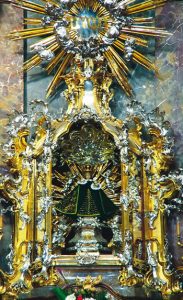
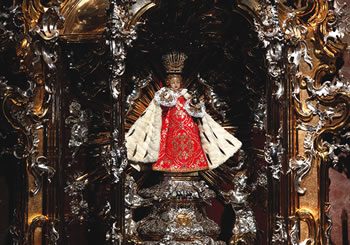
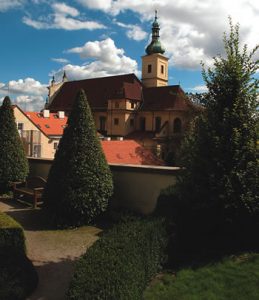
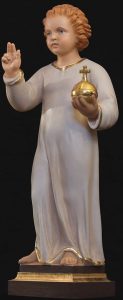
 Entries(RSS)
Entries(RSS)